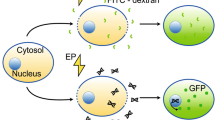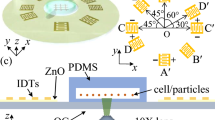Abstract
A cell culture device equipped with a micro-needle electrode array was fabricated for the signal analysis of cell spheroids, cell masses, and cell sheets. For the analysis, sharp needle electrodes with a high aspect ratio for facilitating easy penetration into the cell mass and a small pitch for fine spatial resolution were required. Microelectromechanical systems (MEMS) technology is one of the common solutions for the fabrication of devices. However, an additional process, such as anisotropic etching or electro-polishing, is required for fabricating sharp needles. Tapered needles were fabricated using backside exposure for coating a layer of thick resist film on a glass substrate. The incident beam from mask apertures were diffracted and attenuated in the medium, resulting in tapered intensity distribution. A needle-like shape was obtained after performing resist development without using additional MEMS process. In this study, the theoretical analysis of optical intensity distribution and design and fabrication process of the device were described. Finally, the effectiveness of the device was evaluated by adding cultured cell mass on the needle array. Signals with spikes and fluctuations were observed in the electrode covered with cell mass, whereas only noise was observed on the non-covered electrode, demonstrating the signal pick-up ability of the device during cell culture.










Similar content being viewed by others
References
Y. Ami, N. Miki, Formation of polymer microneedle arrays using soft lithography. J. Micro/Nanolith. MEMS MOEMS 10(1), 011503 (2011)
L.O. Anthony, T.J. Dinison, et al., Multi-electrode array for measuring evoked potentioals from surface of ferret primary auditory cortex. Neurosci. Methods 58, 209–220 (1995)
D. Byun, S.J. Cho, S. Kim, Fabrication of a flexible penetrating microelectrode array for use on curved surfaces of neural tissues. J. Micromech. Microeng. 23, 125010–112513 (2013)
B. Eversmann, M. Jenkner, et al., A 128 128 CMOS biosensor array for extracellular recording of neural activity. IEEE J.Solid-State Circuits 38, 2306–2317 (2003)
A.E. Grumet, J.L. Wyatt Jr., J.F. Rizzo, Multi-electrode stimulation and recording in the isolated retina. J. Neurosci. Methods 101, 31–42 (2000)
K. Kim, D.S. Park, et al., A tapered hollow metallic microneedle array using backside exposure of SU-8. J. Micromech. Microeng. 14, 597–603 (2004)
Y.-C. Kim, J.-H. Park, M.R. Prausnitz, Microneedles for drug and vaccine delivery. Adv. Drug Deliv. Rev. 64, 1547–1568 (2012)
M. McCulloch, T. Jezierski, et al., Diagnostic accuracy of canine scent detection in early- and late-stage lung and breast cancers. Integr. Cancer Ther. 5, 30–39 (2006)
J.-H. Parka, M.G. Allen, et al., Biodegradable polymer microneedles: Fabrication, mechanics and transdermal drug delivery. J. Control. Release 104, 51–66 (2005)
M.C. Peterman, P. Huie, et al., Building thick photoresist structures from the bottom up. J. Micromech. Microeng. 13, 380–382 (2003)
K. Sato, S. Takeuchi, Chemical vapor detection using a reconstituted insect olfactory receptor complex. Angew. Chem. Int. Ed. 53, 11798–11802 (2014)
H. Sonoda, S. Kohnoe, et al., Colorectal cancer screening with odour material by canine scent detection. Gut (2011). https://doi.org/10.1136/gut.(2010).218305
R. Wang, W. Zhao, et al., A flexible microneedle electrode array with solid silicon needles. J. Microelectromech. Syst. 21, 1084–1089 (2012)
Z. Wei, S. Zheng, et al., A flexible microneedle array as low-voltage electroporation electrodes for in vivo DNA and siRNA delivery. Lab Chip 14, 4093–4102 (2014)
N. Wilke, C. Hibert, J. O’Brien, A. Morrissey, Silicon microneedle electrode array with temperature onitoring for electroporation. Sens. Actuators, A 123–124, 319–325 (2005)
Acknowledgements
This study was partially supported by TE Connectivity (TE).
Author information
Authors and Affiliations
Corresponding author
Rights and permissions
About this article
Cite this article
Hatsuzawa, T., Kurosaka, M. A cell culture device equipped with a micro-needle electrode array fabricated using backside exposure mold and resin casting. Biomed Microdevices 20, 58 (2018). https://doi.org/10.1007/s10544-018-0303-7
Published:
DOI: https://doi.org/10.1007/s10544-018-0303-7




